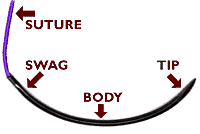
Grip swaged needles by the body and not by the swag to avoid needle damage.
General Tips to Better Technique
|
|
Grip swaged needles by the body and not by the swag to avoid needle damage. |
 Bites
should be about 4-5 mm from wound edges. Sutures should be
spaced about 5 to 7 mm apart, enough to approximate the wound
edges but not so tight to cause ischemic skin edges.
Bites
should be about 4-5 mm from wound edges. Sutures should be
spaced about 5 to 7 mm apart, enough to approximate the wound
edges but not so tight to cause ischemic skin edges.
Loose approximation of wounds produce stronger wound margins
because proliferative activity can occur in the wound clefts, and
proper wound edge alignment is encouraged.

Example of incisional ventral hernia as result of wound healing
complications.
 Retention sutures were
traditionally used to reduce the pressure on wound margins in wounds
requiring strong static tension, i.e., wounds whose edges are
retracted by 5 mm or more. But as would be expected, large sutures
traversing the abdominal wall were often associated with wound
complications. Now abdominal wounds requiring undue tension are often
closed with prosthetic mesh and skin flaps. Image expands
to 29K JPEG.
Retention sutures were
traditionally used to reduce the pressure on wound margins in wounds
requiring strong static tension, i.e., wounds whose edges are
retracted by 5 mm or more. But as would be expected, large sutures
traversing the abdominal wall were often associated with wound
complications. Now abdominal wounds requiring undue tension are often
closed with prosthetic mesh and skin flaps. Image expands
to 29K JPEG.
|
General Guidelines | ||
|
Silk: |
Absorbable braided: |
Monofilament |
 Instrument ties are appropriate for all wounds except
when tension must be carefully adjusted. In those cases, hand ties
are indicated. Image expands to 32K JPEG.
Instrument ties are appropriate for all wounds except
when tension must be carefully adjusted. In those cases, hand ties
are indicated. Image expands to 32K JPEG.We've tied up all the loose ends on wound closure. Visit the Clinical Review site for the next issue when we target colectomy for study.